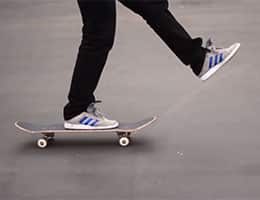 A skateboard is a vehicle or toy that is also known in our language as skate , an English term. It is a board equipped with wheels that is used for skating .
A skateboard is a vehicle or toy that is also known in our language as skate , an English term. It is a board equipped with wheels that is used for skating .
Its origins date back to the 1960s in the United States as an adaptation of the surfboard . Over the years, the skateboard acquired various uses, as it is used for recreation, for competitive purposes and even as a means of transportation in cities.
These objects have two pairs of wheels , one located in the front and the other in the rear. As for the table, it can have different dimensions and characteristics according to the purpose.
To start walking, the skateboarder must place one foot on the ground and push off . Then you have to stand on the board, maintain your balance and let yourself go with the clean and jerk until it is necessary to generate momentum again.
The sport that is based on performing aerial tricks with a skateboard is called skateboarding or skateboarding . The athletes move inside a platform and rise, doing pirouettes with the board.
It is important to keep in mind that, depending on the geographic region, the idea of a skateboard can refer to two similar elements although with different characteristics. In some countries, a skateboard with the properties mentioned in this note is also called a skateboard , while in others a skateboard is a board with wheels and a handlebar used to drive it. In the latter case, the term scooter can also be used.
One of the biggest challenges in learning to ride a skateboard is maintaining balance. There are several factors that make this aspect so difficult for some people:
* a good part of the time is spent with both feet on the board, whose width is usually half that of our body seen from the front;
 * The stability of the skateboard is not its strong point. This is not a defect but a consequence of one of the principles of its design, since if the board were rigidly attached to the wheels it would be more difficult to manipulate it to bend and jump;
* The stability of the skateboard is not its strong point. This is not a defect but a consequence of one of the principles of its design, since if the board were rigidly attached to the wheels it would be more difficult to manipulate it to bend and jump;
* Stepping one foot onto the ground to run while leaving the other on the board can cause a fall if we do it with too much force .
Basically, for these and other reasons, riding a skateboard can mean landing on an unstable structure whose surface is not wide enough to accommodate our upright body. However, once we overcome these obstacles, a world of stunts that only the skateboard allows us can open up to us.
Luckily there are several types of skateboards, which cover the different needs of each user. For beginners, the longboard is recommended, as it is the easiest to maneuver. It is longer than the others, offering greater speed, stability and surface to stand on. On the downside, it is heavier and bulkier than alternative models, which is why it is not ideal for doing many tricks . However, it is increasingly popular for those looking to travel long distances and even participate in professional races.
Choosing the type and model of skateboard is a fundamental step to enter this sporting field. At first it is recommended to choose one with well-supported axles and with as few curves as possible. Footwear is another aspect to take into account: it must be firm and not exceed ankle height, which is why sandals and boots are ruled out.
